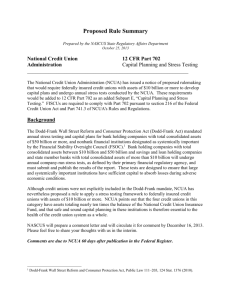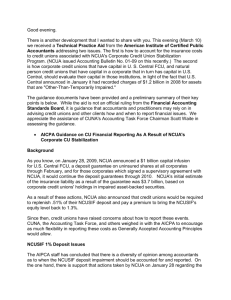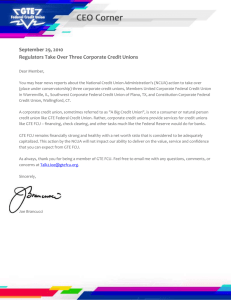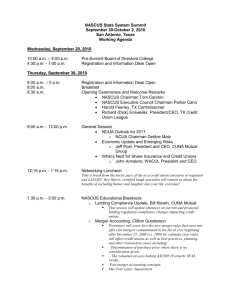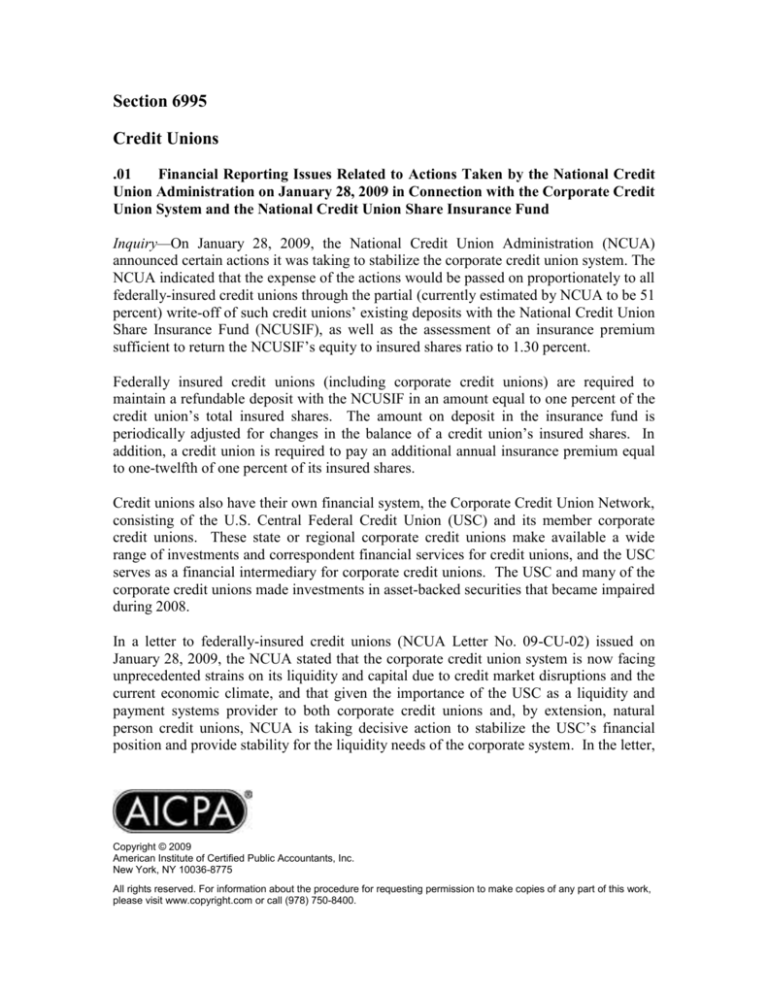
Section 6995
Credit Unions
.01
Financial Reporting Issues Related to Actions Taken by the National Credit
Union Administration on January 28, 2009 in Connection with the Corporate Credit
Union System and the National Credit Union Share Insurance Fund
Inquiry—On January 28, 2009, the National Credit Union Administration (NCUA)
announced certain actions it was taking to stabilize the corporate credit union system. The
NCUA indicated that the expense of the actions would be passed on proportionately to all
federally-insured credit unions through the partial (currently estimated by NCUA to be 51
percent) write-off of such credit unions’ existing deposits with the National Credit Union
Share Insurance Fund (NCUSIF), as well as the assessment of an insurance premium
sufficient to return the NCUSIF’s equity to insured shares ratio to 1.30 percent.
Federally insured credit unions (including corporate credit unions) are required to
maintain a refundable deposit with the NCUSIF in an amount equal to one percent of the
credit union’s total insured shares. The amount on deposit in the insurance fund is
periodically adjusted for changes in the balance of a credit union’s insured shares. In
addition, a credit union is required to pay an additional annual insurance premium equal
to one-twelfth of one percent of its insured shares.
Credit unions also have their own financial system, the Corporate Credit Union Network,
consisting of the U.S. Central Federal Credit Union (USC) and its member corporate
credit unions. These state or regional corporate credit unions make available a wide
range of investments and correspondent financial services for credit unions, and the USC
serves as a financial intermediary for corporate credit unions. The USC and many of the
corporate credit unions made investments in asset-backed securities that became impaired
during 2008.
In a letter to federally-insured credit unions (NCUA Letter No. 09-CU-02) issued on
January 28, 2009, the NCUA stated that the corporate credit union system is now facing
unprecedented strains on its liquidity and capital due to credit market disruptions and the
current economic climate, and that given the importance of the USC as a liquidity and
payment systems provider to both corporate credit unions and, by extension, natural
person credit unions, NCUA is taking decisive action to stabilize the USC’s financial
position and provide stability for the liquidity needs of the corporate system. In the letter,
Copyright © 2009
American Institute of Certified Public Accountants, Inc.
New York, NY 10036-8775
All rights reserved. For information about the procedure for requesting permission to make copies of any part of this work,
please visit www.copyright.com or call (978) 750-8400.
the NCUA announced two significant actions it was taking to address the current status of
the corporate credit union system, as follows:
The NCUA is injecting $1 billion in cash from the NCUSIF into the USC in
the form of capital. The NCUA has stated that while a capital infusion has
cost implications for all credit unions, it is a lower cost alternative than
liquidation and sale of the distressed securities held by the USC in today’s
market. The staff notes that in the unaudited January 2009 financial
statements of the NCUSIF, this investment in the USC was immediately
written off.
The NCUA is offering a voluntary temporary NCUSIF guarantee of member
shares in corporate credit unions through December 31, 2010. The guarantee
will cover all shares, but does not include paid-in capital and membership
capital accounts. The NCUA believes the guarantee helps provide stability to
meet the liquidity needs of the corporate system, which will allow for the
orderly pay down of stressed securities and, in turn, reduces the overall
resolution cost. The NCUA’s initial estimate of the liability attributable to
this guarantee is $3.7 billion, based on current corporate credit union balance
sheets (that is, the holdings of impaired asset-backed securities) and the
modeling of various market scenarios. The NCUA has indicated that this
estimate could change significantly depending on a host of factors including,
but not limited to, credit loss estimates.
In consideration of AU section 560, Subsequent Events (AICPA, Professional Standards,
vol. 1), do the actions of the NCUA constitute a type 1 or type 2 subsequent event with
regard to the valuation of a federally-insured credit union’s NCUSIF deposit at December
31, 2008? Secondly, when and how should the obligation for the insurance premium be
recognized for financial reporting purposes?
Reply—
Issue 1: NCUSIF Deposit. The AICPA staff believes that there is diversity in opinion on
this issue and based on the facts known at the time this question and answer was issued,
the staff does not express a preference for either of the views discussed in the following
paragraphs.
Existing authoritative guidance for the accounting for the NCUSIF deposit is in
paragraph 11 of Statement of Position (SOP) 01-6, Accounting by Certain Entities
(Including Entities With Trade Receivables) That Lend to or Finance the Activities of
Others (ACC sec. 10,850 par. .11), as follows:
a. NCUSIF Deposit. Amounts deposited with the NCUSIF should be accounted
for and reported as assets as long as such amounts are fully refundable. The
refundability of NCUSIF deposits should be reviewed for impairment. When the
2
refundability of a deposit is evaluated, the financial condition of both the credit
union and of the NCUSIF should be considered. Deposits may be returned to
solvent credit unions for a number of reasons, including termination of insurance
coverage, conversion to insurance coverage from another source, or transfer of
operations of the insurance fund from the NCUA Board. However, insolvent or
bankrupt credit unions are not entitled to a return of their deposits. To the extent
that NCUSIF deposits are not refundable, they should be charged to expense in
the period in which the deposits are made or the assets become impaired.
Alternative A—Type 1 Subsequent Event
AU section 560 states that a type 1 subsequent event is an event that provides
additional evidence with respect to conditions that existed at the date of the
balance sheet and affects the estimates inherent in the process of preparing
financial statements. It further states, “All information that becomes available
prior to the issuance of the financial statements should be used by management in
its evaluation of the conditions on which the estimates were based. The financial
statements should be adjusted for any changes in estimates resulting from the use
of such evidence.” AU section 560 also states that subsequent events affecting
the realization of assets, such as receivables and inventories or the settlement of
estimated liabilities, ordinarily will require adjustment of the financial statements
because such events typically represent the culmination of conditions that existed
over a relatively long period of time.
Proponents of type 1 subsequent event accounting maintain that the actions taken
by the NCUA on January 28, 2009 constitute additional evidence regarding
strained liquidity and capital deterioration conditions that existed at December 31,
2008, and that the NCUA announcement on January 28, 2009 of the partial writeoff of the NCUSIF deposit is a confirmation of those conditions at December 31,
2008.
Proponents of this view also believe that Emerging Issues Task Force (EITF)
Issue No. 87-22, “Prepayments to the Secondary Reserve of the FSLIC,”
addresses a situation that may be considered relevant. Similar to the NCUSIF, the
Federal Savings and Loan Insurance Corporation (FSLIC) required insured
institutions to make annual prepayments of their regular future insurance
premiums. In May 1987, the Federal Home Loan Bank Board eliminated the
secondary reserve of the FSLIC as of December 31, 1986. The Task Force
reached a consensus that the impairment of the secondary reserve of the FSLIC
was a type 1 subsequent event.
Alternative B: Type 2 Subsequent Event
AU section 560 states that a type 2 subsequent event consists of those events that
provide evidence with respect to conditions that did not exist at the date of the
3
balance sheet being reported on, but arose subsequent to that date. These events
should not result in adjustment of the financial statements.
Proponents of type 2 subsequent event accounting refer to the NCUA’s
disclosures that it had no obligation to undertake the actions approved on January
28, 2009, and that the NCUSIF deposits were refundable under the circumstances
noted in SOP 01-6 until January 28, 2009. As such, proponents of this view
believe that the NCUSIF deposits did not become impaired until January 28,
2009.
Proponents of this view also believe that EITF Topic No. D-47, Accounting for
the Refund of Bank Insurance Fund and Savings Association Insurance Fund
Premiums, in which the Financial Accounting Standards Board (FASB) staff
expressed their belief that insured institutions should not accrue a liability for a
potential special assessment of deposit insurance premium until the period in
which any proposed legislation is enacted, can be used by analogy to support their
view regarding the NCUSIF deposit.
Issue 2: Premium Assessment.
View A—Record in 2009. Proponents of this view support recognition of the
obligation to pay the insurance premium when assessed, at January 28, 2009, and
refer to SOP 01-6, which states that to the extent that the NCUA Board assesses
premiums to cover prior operating losses of the insurance fund or to increase the
fund balance to "normal operating levels," credit unions should expense those
premiums when assessed.
Further reference is made to the aforementioned EITF Topic No. D-47, in which
the FASB staff expressed their belief that insured institutions should not accrue a
liability for a potential special assessment of deposit insurance premium until the
period in which any proposed legislation is enacted.
View B—Record in 2008. If NCUSIF deposit impairment is recognized in 2008,
proponents of view B believe that both the NCUSIF deposit impairment and the
additional premium assessment relate to the same event and conditions that
caused the deposit impairment that existed at December 31, 2008, and that both
should be recorded as of December 31, 2008.
4


